HISTORY OF BURTON BRADSTOCK PLAYERS
……and earlier entertainment
The 1920s – 1950s
In the late 1920s Mrs Gladys Gale, wife of Robert Gale, butcher and farmer, formed a group of young friends into a Concert 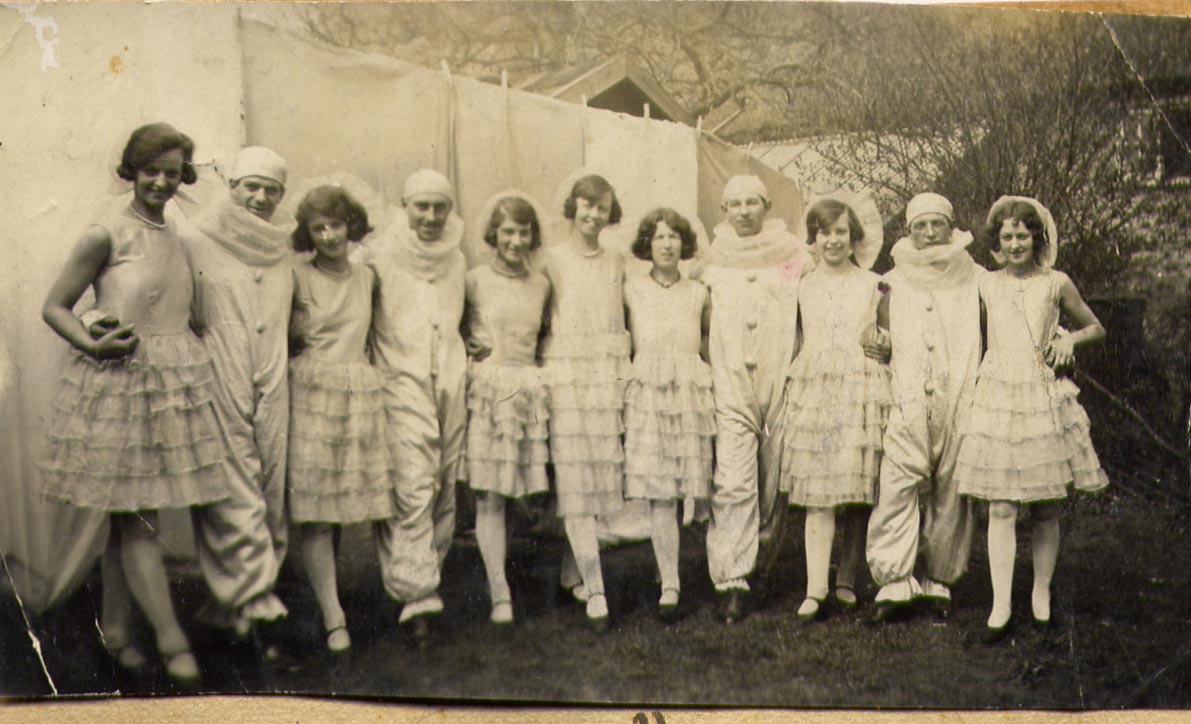 Party. They called themselves THE CHUMS and were, namely: Gladys Gale, May Bartlett, Cynthia Coombes (became Cynthia Stevens), Daphne Bartlett, Carrie and Annie Cammell, Violet Northover, Jim Churchill, Bill Bryant, Alphonso Bartlett and Alfie Hutchings.
Party. They called themselves THE CHUMS and were, namely: Gladys Gale, May Bartlett, Cynthia Coombes (became Cynthia Stevens), Daphne Bartlett, Carrie and Annie Cammell, Violet Northover, Jim Churchill, Bill Bryant, Alphonso Bartlett and Alfie Hutchings.
This group performed a variety of entertainment including songs, dances, comedy acts and sketches in the Pierrot style, dressed in blue Pierrot costumes. So popular were they that they were asked to do entertainments in many villages around Dorset. Their first concert took place in the Schoolroom. Uncle Bob Frost did the lighting with headlights from his car as there was no electricity at that time.
The Chums - 1931
As time went on they expanded into a larger group which became known as Mrs Gale’s Concert Party, and in the 1930s performed many shows in the W.I. Hall. These were variety concerts, usually in two parts, each half with a special theme: cowboys, gypsies, fairgrounds, Army, Navy, etc. Rather than attend an audition as is the custom these days, villagers were ‘requested’ (or persuaded!) to take on a part.
When war broke out in 1939, most of the young people went into the Forces, so the shows came to a halt for a while. However, before long Mrs Gale managed to find enough people to put on several wartime shows, many members of the audience being soldiers stationed in the area. Of course the Blackout was in force, so there was very little lighting and not a chink of light to be seen outside the hall. During the war, troops were billeted into the village and used the W.I. Hall. Apparently, they were so cold during one winter that the stage and a couple of doors from the hall were used as firewood to make a fire! The stage was rebuilt after the war.
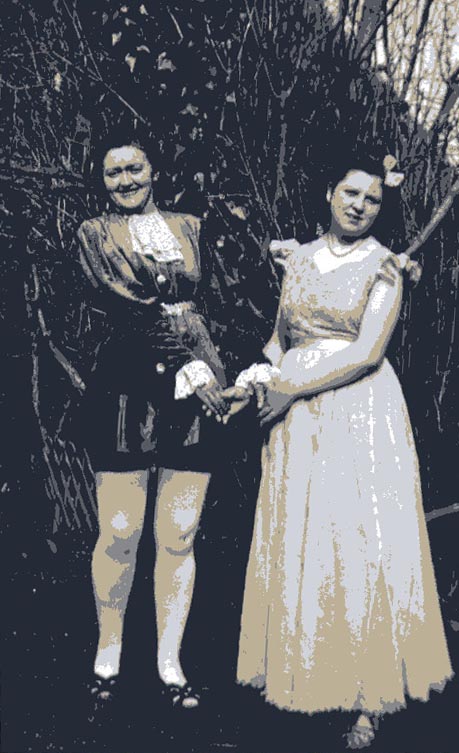 When the war ended and the young people returned, they persuaded Mrs Gale to put on another show and this time it was decided to do a Pantomime. So in 1945, Mrs Gale (Janet Guppy’s aunt) with the help of her sister, Joan Wood (Janet Guppy’s mother), wrote the show “Babes in the Wood”, as well as producing the show and playing the piano for it. The cast made their own costumes. The ‘Babes’ were Freddie Mullins and Leslie Legge, with Joan Wood as Principal Boy (in breeches made of scratchy blackout material) and Jim Churchill was the Dame. Janet Guppy also took part, as well as Greta Heal, Mary Ward and Allie Legge, some of whom, along with Cynthia Stevens, reside in Burton Bradstock to this day, and Georgie Northover still resides in the area. Quite a number of youngsters took part. There was a great deal of talent in the village for singing, dancing and acting and the parts were often written specifically for the individual actors.
When the war ended and the young people returned, they persuaded Mrs Gale to put on another show and this time it was decided to do a Pantomime. So in 1945, Mrs Gale (Janet Guppy’s aunt) with the help of her sister, Joan Wood (Janet Guppy’s mother), wrote the show “Babes in the Wood”, as well as producing the show and playing the piano for it. The cast made their own costumes. The ‘Babes’ were Freddie Mullins and Leslie Legge, with Joan Wood as Principal Boy (in breeches made of scratchy blackout material) and Jim Churchill was the Dame. Janet Guppy also took part, as well as Greta Heal, Mary Ward and Allie Legge, some of whom, along with Cynthia Stevens, reside in Burton Bradstock to this day, and Georgie Northover still resides in the area. Quite a number of youngsters took part. There was a great deal of talent in the village for singing, dancing and acting and the parts were often written specifically for the individual actors.
Photo: Janet Guppy and her mother as Maid Marion and Robin Hood in “Babes in the Wood”, 1945.
In 1948 they produced “Dick Whittington” and Janet Guppy played the Fairy Queen and in 1950 “Mother Goose”. There were two pianos used this time, played by Constance Westerman (who had some connection with the Halle Orchestra) and Vera Maclean (of Happidrome fame). A ticket for a performance cost 1/6d.
Mrs Gale produced a ‘Variety Roundabout’ in the early 1950s, after which it would appear there was a gap of about 10 years.
The 1960s – 1980s
In the early 1960s, Burton Bradstock W.I. must have felt that the village needed some entertainment once again and they began to put on productions. In 1962 there was a trio of one-act plays that included a Potted Panto. This was produced by Marjorie Constant, with Miss B Channin and Violet Bull helping backstage and Dora Stark on the piano. After a double bill of playlets in the couple of years that followed, and “Aladdin Revisited” (a fantasy on a panto theme), full-length Pantomime became the order of the day, starting with “The Queen of Hearts” in 1966. Published scripts were generally used.
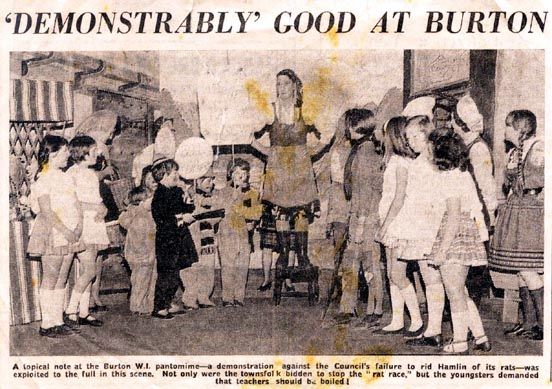
Picture from the local press in 1969
“The Pied Piper” was produced in 1969 and that was the first pantomime in which Mary Bailey performed. Stella Bowie played the Piper. Mary is still a member (now Burton Bradstock Players) and always runs the raffle. Many traditional and well-known pantos were performed between 1969 and 1980, including such titles as “Cinderella”, “Dick Whittington”, “Aladdin”, “Robin Hood”, and all parts were played by women. Children from the village usually took part. Jane Hillis painted much of the scenery and organised costumes.

Back row L to R: Sally Aylott, Minique Brown, Mary Bailey, Rene Dorrell, Wune Williams, Georgie Northover, Hilary Macy, Kay Bugler, ??Peggy Cross??, Thelma Aylott, Jane Hillis
Children L to R: Susan Guest, Susan Oakford, Rebecca Bailey, Catherine Greenyer, Rachael Barnes, Linda Knell
The Rats L to R: Janet Youngs, May Harrison, Peter Guest, Lawrence Brown, Dianed Bailey, Helen Knell
Names kindly given by Thelma Aylott and Mary Bailey - November 2012
There are strong rumours that, in those days, a very kind lady from the village brought along Dorset Apple Cake for the interval and a little cider was drunk in the dressing room!
Men sometimes helped backstage and then, in 1981, the big change came! The W.I. finally allowed men to join the cast of “Mother Goose”. As the press commented at the time: “Probably the last female bastion of Burton Bradstock – the W.I. pantomime – has been conquered by the village’s men.” Val Gale had started to produce the shows and went on to produce 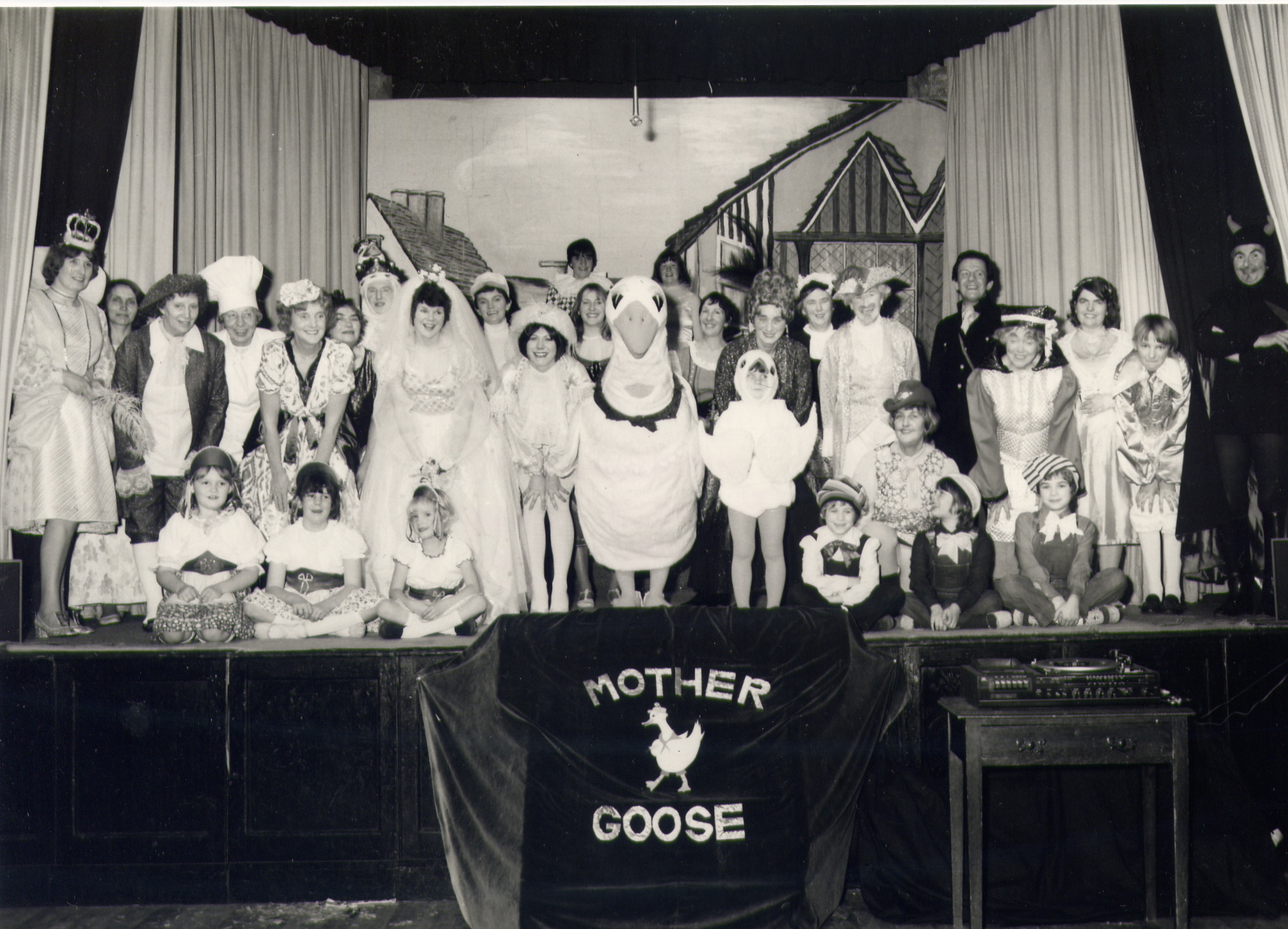 quite a number of the pantos in the years ahead. During these years, the group was mostly called Burton Bradstock Village Pantomime or W.I. Pantomime. Doris Gluning was a stalwart of the society for 12 productions as piano accompanist, as well as producing the show on some occasions, stepping down finally in 1982.
quite a number of the pantos in the years ahead. During these years, the group was mostly called Burton Bradstock Village Pantomime or W.I. Pantomime. Doris Gluning was a stalwart of the society for 12 productions as piano accompanist, as well as producing the show on some occasions, stepping down finally in 1982.
During this period the W.I. Players generally took part in the Burton Bradstock Carnival procession. This was an important event in the village but one which has, sadly, not survived the years.
The cast of “Mother Goose” in 1981
In 1979 the group first used the name “Burton Bradstock Players” but only took this name permanently from 1986. Around this time Cynthia Stevens stepped down from performing after about 55 years!
The 1980s - 2008
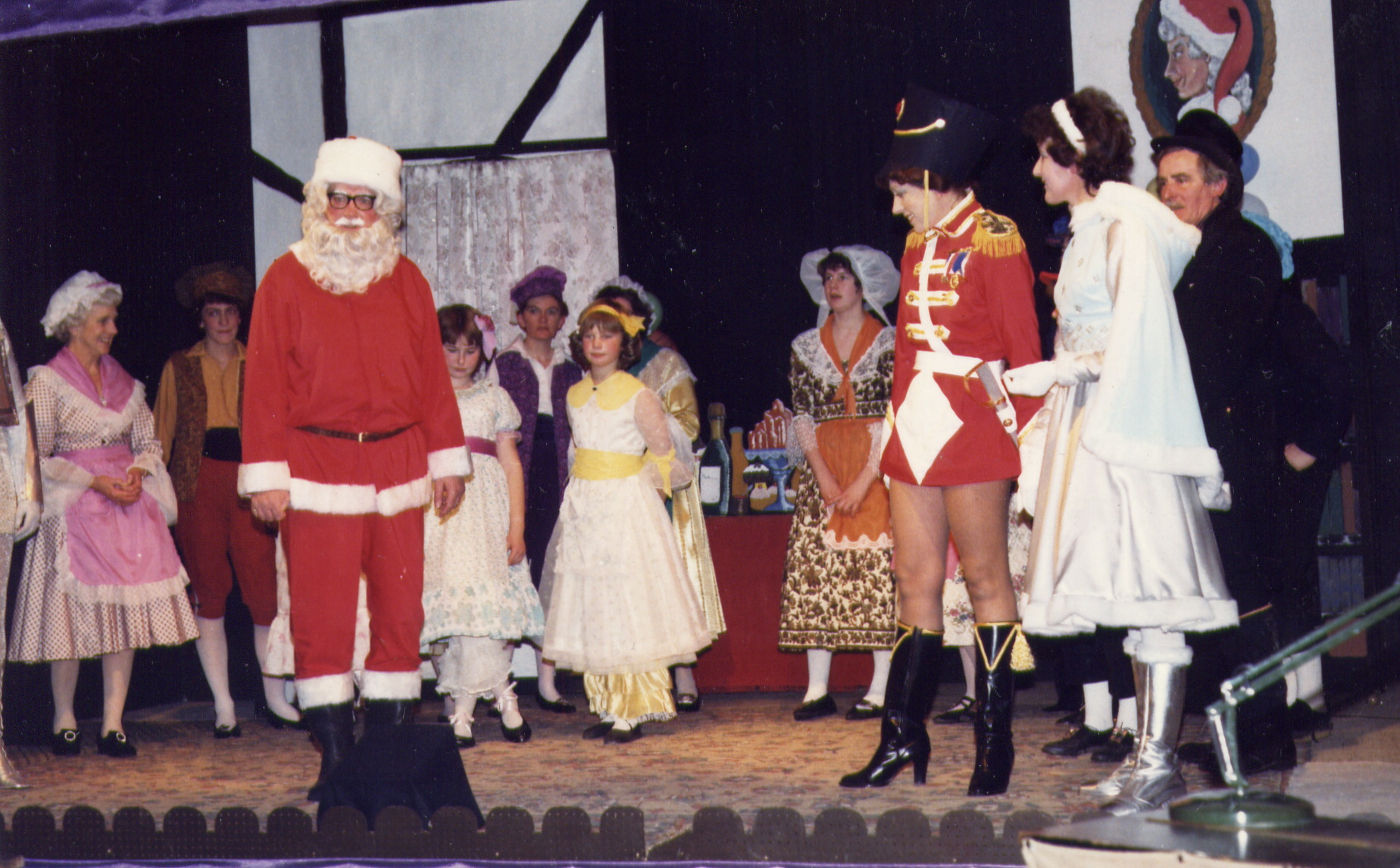 From 1986 until 2000, a full-length pantomime was produced every year, usually in February, and the Players became known for their artistic and creative sets, colourful costumes and good family entertainment. Janet Guppy was still performing and did so until the early 1990s. Val Gale produced several more and then Mike Read (one of the first men allowed in in 1981!) took up the baton. There were other invited Producers during that time too. Anne Southgate became musical director, and later on Shirley Ewart would regularly choreograph for the cast.
From 1986 until 2000, a full-length pantomime was produced every year, usually in February, and the Players became known for their artistic and creative sets, colourful costumes and good family entertainment. Janet Guppy was still performing and did so until the early 1990s. Val Gale produced several more and then Mike Read (one of the first men allowed in in 1981!) took up the baton. There were other invited Producers during that time too. Anne Southgate became musical director, and later on Shirley Ewart would regularly choreograph for the cast.
In 1986 the panto was “Santa in Space” (pictured), perhaps reflecting the modern age, and then 14 traditional titles – one a year – until 2000 when Val Gale returned to produce “Cinderella”.
At that period the Players entered Pantomime competitions run by Calor Dorset, winning best costumes for “Sleeping Beauty” in 1994 and a runner-up certificate for ‘Production’ for “Goldilocks and the Three Bears” in 1996.
Mike Read and John Surry more or less took it in turn to play the Dame during this period, with John Tillman taking a turn too, and were renowned for their repartee and ad libbing, keeping the audience laughing with topical and local references.
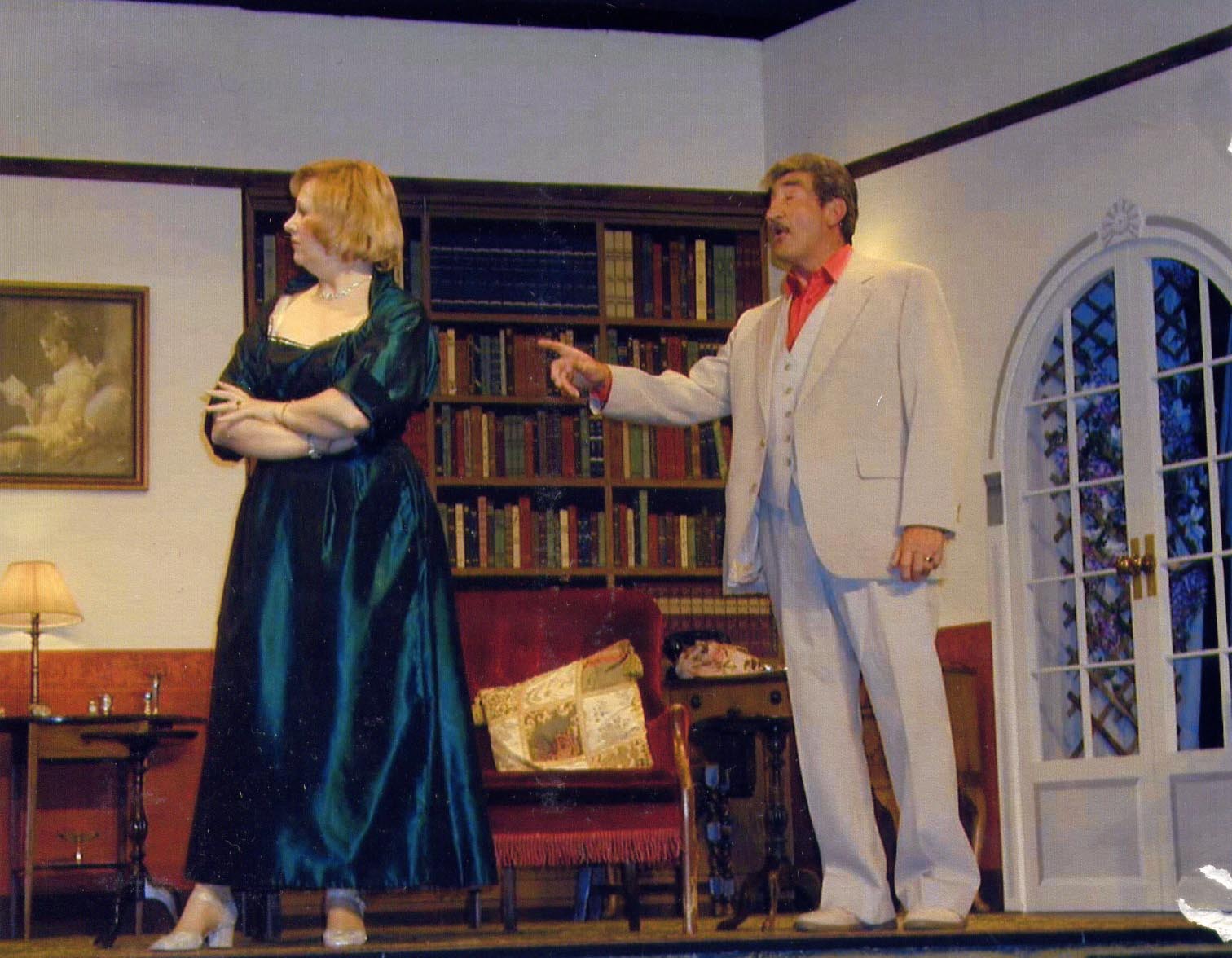 There was no production in 2001 but with some ‘new blood’ arriving in the village, the Players ‘regrouped’ and the smell of the greasepaint called once more! So much so that there were two productions in 2002 – Mike Read directed “Aladdin” and a new and enthusiastic member to the Players and the village, Daphne Ekins, directed the Noel Coward play “Relative Values”. The play was a new departure for the Players and was well received in the village. A box set had to be constructed for the play and Mike Southgate made all the flats. Mike had been Chairman for four years, had taken part in pantomimes for some years and also took part in this first play.
There was no production in 2001 but with some ‘new blood’ arriving in the village, the Players ‘regrouped’ and the smell of the greasepaint called once more! So much so that there were two productions in 2002 – Mike Read directed “Aladdin” and a new and enthusiastic member to the Players and the village, Daphne Ekins, directed the Noel Coward play “Relative Values”. The play was a new departure for the Players and was well received in the village. A box set had to be constructed for the play and Mike Southgate made all the flats. Mike had been Chairman for four years, had taken part in pantomimes for some years and also took part in this first play.
Glenys Davies and Len Green in “Relative Values”
Andrea Wilkinson became known for creating wonderful costumes for the pantomimes, with the assistance of Elaine Colbert. She also took part in many and was Secretary of the Players for eight years. John Tillman was a stalwart of the Players over this period of time and also took his turn as Chairman. John also did the initial research and notes for this History of the Players.
Anne Southgate had stepped down from her musical director’s role by this time, and various accompanists helped the Players.
Another panto followed in 2003 with “Hickory Dickory Dock”, directed by Miles Bell, and then the comedy “Breath of Spring” in June, directed again by Daphne Ekins. “Snow White” in 2004, a personal favourite of the writer of this History, was directed by Mike Read, and was the last
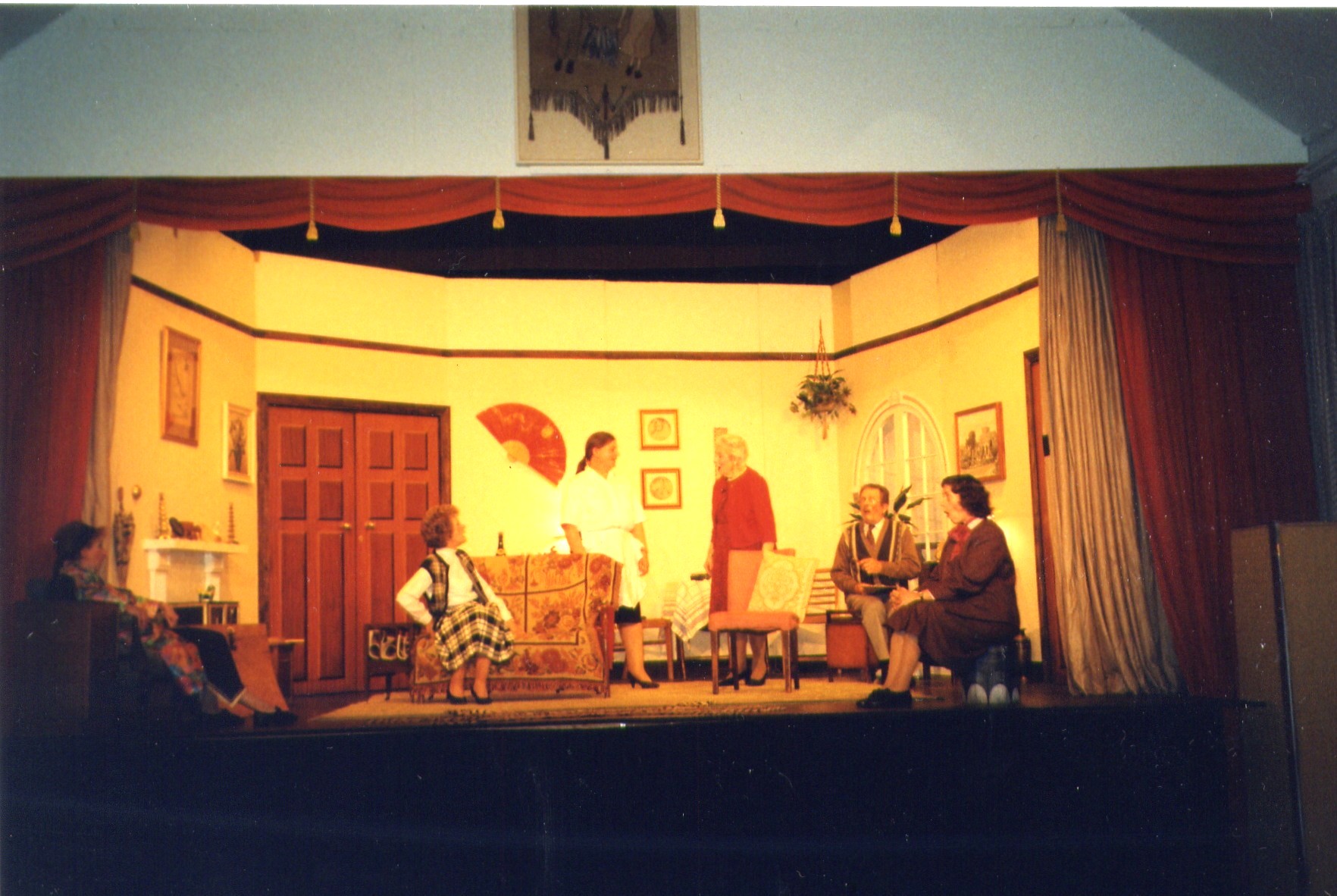
Liz Mackay, Liz Slater, Sue Linford, Joan Armstrong, Mike Read and Gill Knight in “Breath of Spring”
pantomime to be produced until the present time (though watch this space for next year’s production details!). Josie Powell played the heroine with her sister, Libby, as The Fairy. The Seven ‘Friends’, played by young local girls, were a delight to watch having received excellent choreography from Shirley Ewart.
Daphne Ekins directed 3 of Alan Bennett’s monologues “Talking Heads” in May 2004 which received an Accolade of Excellence award from NODA (National Operatic and Dramatic Association).
Since that date, members of the Players have been inspired to take on new and innovative ideas, not so much in the titles of productions but in the artistic direction as a whole and use of the auditorium. 2005 saw Liz Slater – one of the Players’ leading actresses in the plays – direct “Wind in the Willows” which gave the make-up artists a challenging and, no doubt, rewarding time! Rachel Haley had taken on leading the make-up team and is still an enthusiast in that department. It was also a challenge for the construction crew when Ian Allan and Trevor Ekins made a car, caravan and boat, beautifully painted by Peter Billingham.
Clockwise, left to right: Gill Knight as Mole, Chris Knight as Badger, Jake Dove as Ratty and Mike Read as Toad in “Wind in the Willows”.
In 2006, “The Wizard of Oz” in February was followed by Agatha Christie’s “A Murder is Announced” in June, the part of Miss Marple being played by another of the Players’ leading actresses, Joan Armstrong.
A musical adaptation of “The Railway Children” in 2007, directed by Chris Knight and Barbara Powell, saw the whole auditorium dressed to give the atmosphere of a 1905 railway station and a huge red steam engine filled the stage at the opening. Shirley Ewart, the Players’ choreographer for some years, directed “Stepping Out” in June that year, which brings this History to our current year, 2008. This year already the musical show has taken place – again, a very innovative production performed in the round. Shirley Ewart and Barbara Powell (a Players’ member and performer for many years and current Chairman) wrote and directed an adaptation of The Three Musketeers called “All For One”. In true Players’ style, the cast for this show were trained in the art of fencing by Shirley Parker (a Commonwealth Games champion who just happens to live in the village!).
The play has been moved to the first week of September this year and will be “Lord Arthur Savile’s Crime”. Mike Read is finally given the chance to direct a play, having been keen to do so in the 1980s. Mike was the first Treasurer for the Players in the early eighties, has always served on the committee, and is Treasurer today.
CONCLUSION
Generations of families have taken part in Players’ productions, treading the boards year after year from childhood to adult. Traditions have inevitably been formed – one of them would appear to be that members of the clergy in the locality, and/or their wives, should take part on occasions! It is almost traditional to play to full houses – if that can be classed as a tradition – and in the earlier days of pantomime a queue would form outside the Post Office on Box Office opening day! Audiences have been made up not only of villagers but people from Bridport, the Bride Valley and the surrounding
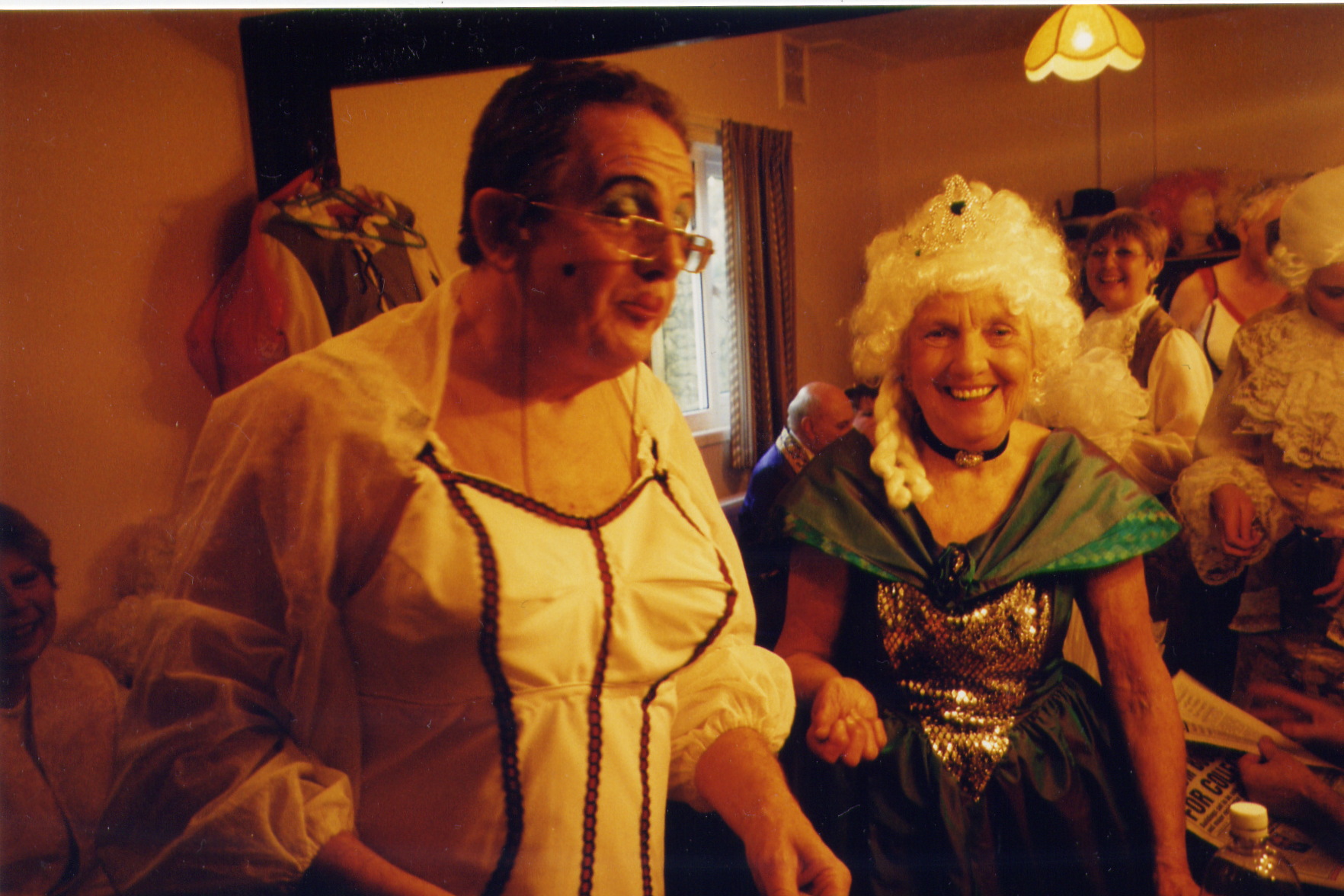 area. The Players have gained a good reputation and, though there have been times when the Press have not been so enamoured with a show, in general the reviews have been good.
area. The Players have gained a good reputation and, though there have been times when the Press have not been so enamoured with a show, in general the reviews have been good.
Mike Read dressing for ‘Dame’ and Mary Bailey – “Cinderella” 2000
It would be impossible to name all the individuals and teams of volunteers who have given their time and talents over the last 80 years to ensure that Burton Bradstock entertained. Burton Bradstock Players, and those who came before them, have been very fortunate to encounter such dedication.
Entertainment has been an important part of community life in Burton Bradstock since the 1920s (or maybe earlier if records come to light). Apart from the Players’ productions, other villagers have organised occasional entertainment; for instance Elaine Colbert for several years produced a variety show biennially; in 1982 there was a Community Play called “Ssh!” initiated by Pat and Norman Saunders-White and written and directed by Andrew Dickson; and this year is the 28th Burton Bradstock Festival of Music and Art, originally organised by Mary Ryan but for the last 10 years by Mike Southgate.
It is hoped that the years ahead will create more ‘History’.
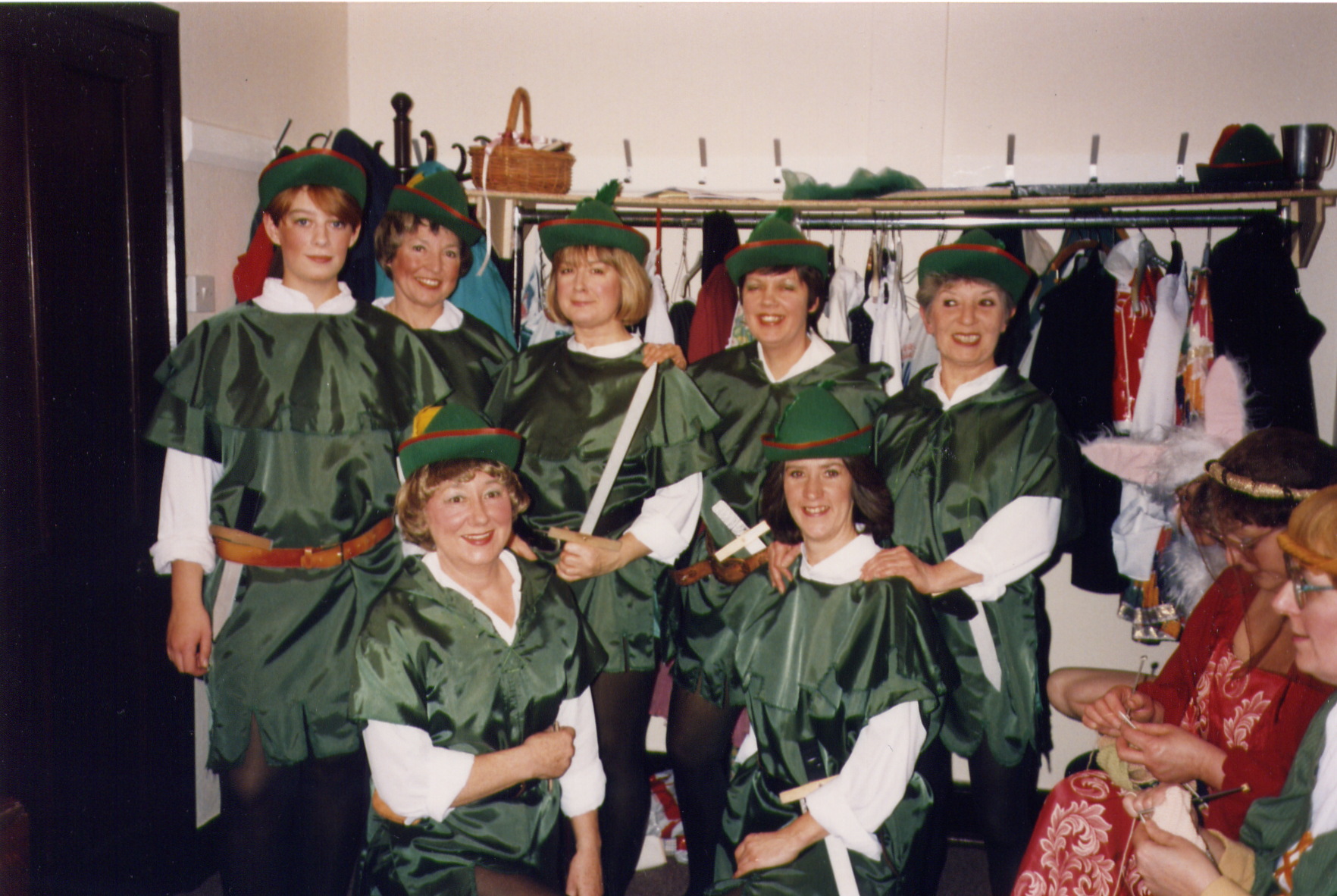
Chorus of “Babes in the Wood” 1995
More photos to be found on the Players’ page of this website.
Daphne Ekins
Initial research and notes: John Tillman
August 2008
With very grateful thanks for information and photos to:
Mary Bailey
Janet Guppy
Cynthia Stevens
And others